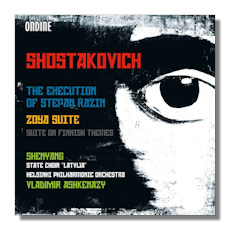
The Internet's Premier Classical Music Source
Related Links
- Shostakovich Reviews
- Latest Reviews
- More Reviews
-
By Composer
-
Collections
DVD & Blu-ray
Books
Concert Reviews
Articles/Interviews
Software
Audio
Search Amazon
Recommended Links
Site News
 CD Review
CD Review
Dmitri Shostakovich

- The Execution of Stepan Razin *
- Zoya Suite
- Suite on Finnish Themes **
* Shenyang, bass-baritone
* Mari Palo, soprano
* Tuomas Katajala, tenor
** State Choir "Latvija"
Helsinki Philharmonic Orchestra/Vladimir Ashkenazy
Ondine 1225-2 66m
This CD contains a wide variety of Shostakovich, from his dead-serious side (The Execution of Stenka Razin) to Shostakovich the composer of movie music (Zoya) and finally to Shostakovich the arranger (Suite on Finnish Themes). All three works share one thing in common of course – each involves choral and/or solo vocal music.
The most substantial of the trio is The Execution of Stenka Razin. Some transliterations state the name of the title character of the work as Stepan Razin, as is given on the front and back album covers here. Yet, in the translation of the text, the album gives the more correct "Stenka". However you call the piece, it is one of Shostakovich's more important works and Ashkenazy's account of it is excellent. What I noticed immediately here more than in any other interpretation was the sense of tension, of forward thrust. The music is alive, brimming with tension, not just in the lively opening sequences but in the slower music that follows.
It is thus no surprise that Ashkenazy's timing of 25:34 is the fastest I've ever encountered in this work. Herbert Kegel (Decca) and Andrei Andreev (Koch International) take over 31 minutes! I reviewed the recording of Stenka Razin by Gerard Schwarz here (Naxos 8.557812) in 2006 and found it quite compelling. At 28:37, it was moderately paced but fully competitive with any previous version. Now I believe I would give a slight edge to this new effort by Ashkenazy on Ondine. Both the Schwarz and Ashkenazy versions feature excellent singing by their soloists and choruses, as well as fine playing by their respective orchestras. Ashkenazy infuses the music with tension and an unsettling sense that combine for an electric surge throughout the score. Interior episodes, especially those involving percussion, come through with a powerful bluntness, and the mesmerizing singing of the bass-baritone Shenyang adds to the high quality here. Even the Kondrashin recording on Melodiya from the 1960s was not quite this compelling, good though it was.
As for the Zoya Suite, it contains several attractive numbers and can certainly be called good movie music. While that may come across as damning with faint praise, it is meant to be a positive assessment. Shostakovich probably never meant for the music to be heard in the concert hall, as he did not extract this suite of five numbers. That was done by Levon Atovmyan (not Atomvyan, as erroneously given in the notes), who made suites from a number of Shostakovich film scores, including The Young Guard (1947-48), The Gadfly (1955), and Five Days and Five Nights (1961). The music in Zoya is quite often bombastic as in March (No. 4) or Finale (especially its closing moments), to cite just two examples. But it can also be quite tuneful: after the overblown fanfares and brass and choral proclamations given at the outset in the Introduction, there follows a quite lovely theme played by the strings, and soon another attractive melody is presented by the chorus. This is probably the best track among the five in the work. Back in 2010 I reviewed another recording of Zoya, a CD with Walter Mnatsakanov leading Byelorussian Radio & TV Symphony Orchestra, (Delos DRD2001) and found it quite fine. But its coupling was The Young Guard, not a substantial Shostakovich work, unless you're enamored of his film scores.
The Seven numbers comprising the Suite on Finnish Themes are quite light in character and often folkish sounding. All but Nos. 1 and 3 feature a vocal soloist. Here soprano Mari Palo delivers spirited versions of Nos. 2 and 4, The Sky is Blue and White and The Girls of This Village. In the latter number and in #6, If I could be at Leisure, she is joined tenor Tuomas Katajala, who also sings splendidly. He turns in fine work as well in #5 The Strawberry is a Red Berry. Overall, this is an attractive work of rarely encountered Shostakovich arrangements that should appeal to the composer's admirers. The sound on the disc is excellent and the notes are informative.
Copyright © 2013, Robert Cummings





















